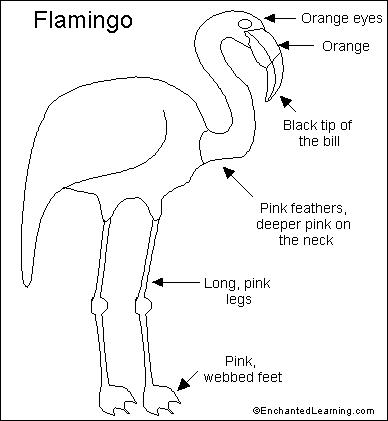
 |
| You might also like: | Flamingo Printout (simple) | Label the Flamingo Printout | Guinea Pig Printout | Baboon Printout/Coloring | Seal Printouts | Today's featured page: Bottlenose Dolphin Printout |
| Go to a Flamingo Quiz More Information on Birds | EnchantedLearning.com Flamingo | Animal Printouts Label Me! Printouts |


When a flamingo flies, its long neck and legs make a nearly straight line. Flamingos live to be about 50 years old.
Feathers: The flamingo's bright pink color is due to its diet. The carotene from the shrimp or other shrimp-like crustaceans in its diet turns its feathers pink. If the diet is low in carotene, the feathers become white.
Anatomy: Flamingos have a very long neck and long, pink legs with big, pink, webbed feet. Adults grow to be about 4 feet (1.2 m) tall. Their long bill turns downward in the middle; it is yellow/orange with a black tip. The large bill is used in filter feeding. The eyes are orange-yellow.
Habitat: Flamingos prefer alkaline (the opposite of acid) waters. Flamingos are native to South/Central America and Africa (flamingos are not native to the USA). They are found in warm, tropical areas, desert lakes (in East Africa), and cold mountain lakes (in the Andes mountains).
Diet: The flamingo eats insects, crustaceans (shrimp and other shrimp-like animals), and tiny plants like diatoms and algae. The flamingo eats by putting its head upside-down into the water looking backwards. It takes in water that is rich in tiny organisms and filters nutrients from the water with a comb-like organ on its tongue.
| Search the Enchanted Learning website for: |